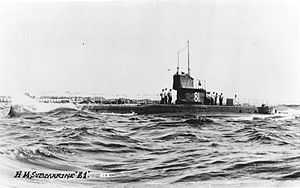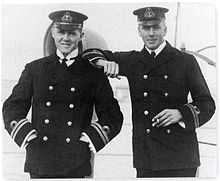HMS E1
 | |
| Career | |
|---|---|
| Name: | HMS E1 |
| Builder: | HM Dockyard, Chatham |
| Cost: | £101,700 |
| Laid down: | 14 February 1911 |
| Launched: | 9 November 1912 |
| Commissioned: | 6 May 1913 |
| Fate: | Scuttled, 3 April 1918 |
| General characteristics | |
| Class and type: | E-class submarine |
| Displacement: | 665 long tons (676 t) surfaced 796 long tons (809 t) submerged |
| Length: | 178 ft (54 m) |
| Beam: | 15 ft 5 in (4.70 m) |
| Propulsion: | 2 × 1,750 hp (1,305 kW) diesel 2 × 600 hp (447 kW) electric 2 propellers |
| Speed: | 15 knots (28 km/h; 17 mph) surfaced 9.5 knots (17.6 km/h; 10.9 mph) submerged |
| Range: | 3,000 nmi (5,600 km) at 10 kn (19 km/h; 12 mph) 65 nmi (120 km) at 5 kn (9.3 km/h; 5.8 mph) |
| Complement: | 30 |
| Armament: | 4 × 18 in (457 mm) torpedo tubes (1 bow, 2 beam, 1 stern) |
HMS E1 (laid down as HMS D9) was a British E-class submarine that was built by Chatham Dockyard and cost £101,700. E1 was laid down on 14 February 1911. She was launched on 9 November 1912 and was commissioned on 6 May 1913. During World War I she was part of the British submarine flotilla in the Baltic.
Service history

She worked with E5 and reconnoitered the Skagerrak as a prelude to sending submarines into the Baltic. Then on 15 October 1914, she and E9 sailed from Gorleston in a successful attempt to penetrate the German defences and enter the Baltic. On 18 October 1914, E1 unsuccessfully attacked the armoured cruiser SMS Victoria Louise in Kiel Bay. The torpedo ran too deep and missed.[1] On 19 August 1915, she torpedoed and damaged the German battlecruiser Moltke (23,000 tons) during the Battle of the Gulf of Riga.
E1 's service ended on 3 April 1918 outside Helsinki, 1.5 nautical miles (2.8 km) off Harmaja Light in the Gulf of Finland. She was scuttled by her crew, along with E8, E9, E19, C26, C27, and C35 to avoid seizure by advancing German forces which had landed nearby.
Notes
- ↑ Compton-Hall, pp. 137–138
References
- Compton-Hall, Richard (2004). Submarines at War 1914–1918. Penzance: Periscope Publishing. ISBN 1904381219.
- Submarines, war beneath the waves, from 1776 to the present day, by Robert Hutchinson.
- The Royal Navy Submarine Service, A Centennial History, by Antony Preston.
- E 1 in hylyt.net (Finnish)
- Finnish Submarines in Finnish Navy in World War II